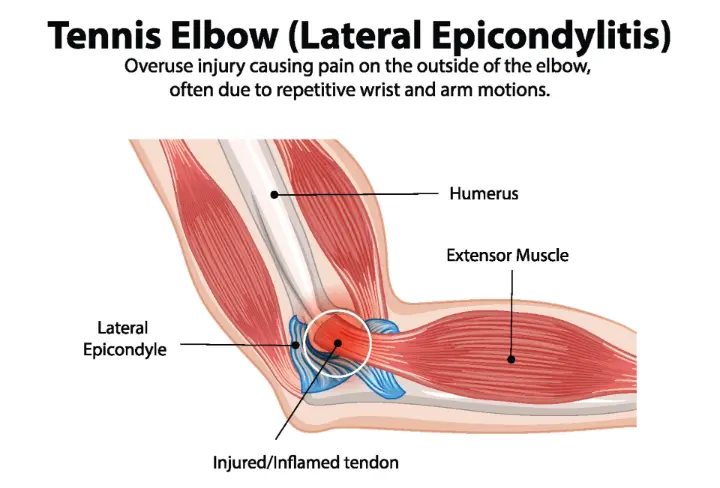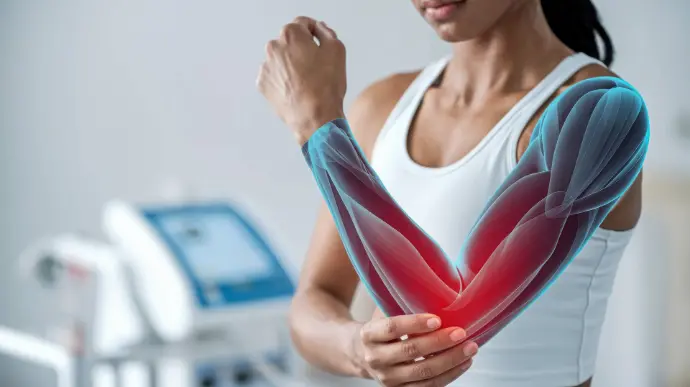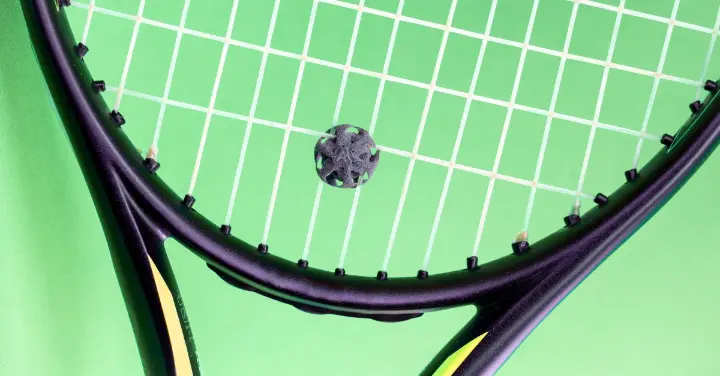Elbow pain is a common issue among athletes, craftsmen, digital workers, and anyone performing repetitive arm movements. One of the main causes is lateral epicondylitis, better known as tennis elbow. This tendon inflammation can make even simple movements, like lifting a cup or shaking hands, difficult and may even negatively impact sleep.
But what causes epicondylitis? What are the most effective treatments and recommended exercises to relieve pain and prevent this bothersome condition? Who should you turn to for treatment? And most importantly, do tennis elbow braces or Tennis Racket Dampeners really make a difference?
In this article, we will answer these and other questions, providing a comprehensive overview to help those suffering from epicondylitis find a effective solutions, both in tennis and in daily life!
What Is Epicondylitis and Why Is It Called “Tennis Elbow”?
What Is Epicondylitis?
Lateral epicondylitis is an inflammation of the tendons that connect the forearm muscles to the lateral epicondyle of the humerus, a bony insertion point on the outer part of the elbow. Pain occurs in this area and may radiate down the forearm, making movements that involve gripping or wrist rotation difficult.

This condition is commonly called "tennis elbow" because it is widespread among tennis players, who constantly strain their forearm muscles with repetitive, high-intensity movements. However, it can also affect people who perform repetitive manual tasks, such as craftsmen, workers, musicians, or those who spend long hours at a computer.
The Origin of the Term "Tennis Elbow"
While it might seem clear why this inflammation is known as tennis elbow, let's delve into the history of this name and clear up some misconceptions surrounding it.
The term "tennis elbow" has its roots in sports medicine history. Although epicondylitis was already known and described in the 19th century, it was only in the early 20th century that the link with tennis became predominant.
Tennis became a popular sport, with its repetitive and vigorous arm movements, especially the backhand. Doctors noticed a significant incidence of elbow pain among players, leading to a direct correlation between playing tennis and this condition.
This term, although effective in communicating the condition, can be misleading, as epicondylitis affects many people who do not play tennis and does not necessarily affect athletes who practice this wonderful sport.

Today, it is widely recognized that epicondylitis can result from a variety of activities that excessively stress the forearm muscles. However, the term "tennis elbow" persists, testifying to its historical importance in the understanding and dissemination of knowledge of this condition.
In summary, the term originated from the observation that many tennis players suffered from this condition. However, it is important to remember that the causes are diverse and not limited to tennis. Additionally, proper tennis technique can prevent this inflammation from occurring.
Are Epicondylitis and Golfer’s Elbow the Same Thing?
The answer is no. Golfer’s elbow (medial epicondylitis) is a similar inflammation affecting the elbow, but with key differences. While the two conditions are often confused, the main distinction lies in the pain’s location:
- Epicondylitis affects the outer part of the elbow.
- Golfer’s elbow affects the inner part of the elbow.
Similarly to tennis elbow, the latter is also known as golfer's elbow, due to the frequency with which this injury affects those who play golf.
What Causes Epicondylitis?
Epicondylitis is caused by excessive and repetitive strain on the forearm muscles, leading to micro-tears in the tendons. As mentioned, it does not only affect athletes: people with jobs that require constant use of the hands and forearm can also develop this condition.
Repetitive movements, continuous vibrations, or heavy loads on the arm (such as using a drill, working on a computer, or lifting weights) increase the risk of tendon overload.
Epicondylitis in Tennis

In tennis, epicondylitis often arises due to incorrect technique, off-center ball impact, improper grip and a too high racket string tension.
These issues can be corrected by working with a tennis coach and now we will highlight the common causes of Tennis Elbow in tennis players:
Incorrect Technique:
- A one-handed backhand heavily stresses the wrist extensors, which are responsible for epicondylitis.
- Poor technique, such as excessive wrist flexion or hitting the ball too close to the body, increases tendon strain.
- The serve can also contribute due to the wrist rotation and ball impact.
Off-Center Ball Impact:
- Hitting the ball off-center or with excessive vibration transmits harmful forces to the elbow.
- The impact should be clean and smooth to minimize tendon stress.
Incorrect Grip:
- A grip that is too tight or too loose affects shot biomechanics and increases elbow strain.
- The grip must be appropriate for the stroke type and player’s characteristics.
A Too High Racket String Tension:
- Higher string tension increases the stiffness of the racket’s string bed, transmitting more vibrations to the arm.
- This overloads the tendons and promotes epicondylitis.
- Even racket weight matters: too heavy or unbalanced rackets put additional stress on the elbow joint.
The Importance of Technical Correction
Tennis-related epicondylitis is often the result of technical and biomechanical factors.
Correcting playing technique, choosing suitable equipment, and maintaining physical conditioning are essential for preventing this condition.

To wrap up:
- Consulting a qualified tennis coach is essential to identify and correct technical errors.
- A biomechanical analysis of strokes can reveal movements contributing to epicondylitis.
- A coach can provide personalized guidance to improve technique and reduce injury risk.
- Proper warm-up and physical training are also crucial for prevention.
How to Recognize Tennis Elbow Symptoms
Recognizing epicondylitis early is crucial to prevent worsening symptoms. The main tennis elbow symptoms include:
- Localized Pain:
- Pain occurs on the outside of the elbow, at the lateral epicondyle.
- It may radiate down the forearm to the wrist.
- Pain During Movement:
- The pain worsens with activities that involve forearm muscles, such as gripping objects, rotating the wrist, or extending the arm.
- Even simple daily actions, such as shaking hands or lifting a cup, can be painful.
- Weakness:
- A feeling of weakness in the grip may be felt, making it difficult to lift or grip heavy objects.
- Pain Upon Touch:
- The area of the lateral epicondyle is painful to the touch.
- Pain During Specific Tests:
- Specific tests exist, such as Cozen's test, which can help confirm the diagnosis. This test involves extending the wrist against resistance, and if pain is felt, it is a sign of tennis elbow epicondylitis.
How Is Tennis Elbow Treated?
The treatment of epicondylitis varies depending on the severity of the inflammation.
In the initial stages, pain can be managed with rest and ice application. It is essential to reduce or temporarily suspend the activity that caused the problem, to allow the tendons to heal.
Physiotherapy also plays a key role in rehabilitation. A program of specific exercises helps to strengthen the forearm muscles and improve elbow mobility, not only reducing the risk of recurrence but also ensuring blood circulation in this area, to accelerate the healing process. Techniques such as deep transverse massage and shock wave therapy can accelerate healing and relieve pain.
In more severe cases, anti-inflammatory drugs or, in rare cases, corticosteroid injections may be prescribed. However, these solutions offer temporary relief and do not solve the root cause of the problem. The main goal must always be functional recovery through controlled and progressive movement.
By understanding the causes, symptoms, and treatments, individuals affected by tennis elbow can take proactive steps to manage and prevent this condition effectively! 🎾💪

Who to Consult for Tennis Elbow Treatment
When symptoms of tennis elbow epicondylitis occur, it is essential to contact qualified professionals for an accurate diagnosis and effective treatment. The reference figures include:
- General practitioner: The general practitioner can provide an initial assessment of symptoms and refer the patient to specialists.
- Orthopedic surgeon: The orthopedic surgeon is the specialist in pathologies of the musculoskeletal system, including the elbow. They can diagnose epicondylitis, prescribe drug therapies or injections, and assess the need for surgery in more severe cases.
- Physiotherapist: The physiotherapist is essential for the rehabilitation of epicondylitis. They can develop a personalized exercise program to strengthen muscles, improve mobility, and reduce pain. They use manual therapy techniques, such as massages and mobilizations, and physical therapies, such as ultrasound or laser.
- Tennis coach: If tennis elbow epicondylitis was caused by incorrect movements during tennis play, it is essential that a qualified tennis coach can review the movements and correct any errors.
Home Remedies for Tennis Elbow Treatment: Tradition and Relief
Over time, various traditional remedies have emerged to alleviate the symptoms of epicondylitis. Although they do not replace specialized treatments, they can offer temporary relief from the sensation of inflammation:

- Cold Compresses: Applying ice packs to the affected area for 15-20 minutes multiple times a day can reduce inflammation and pain.
- Warm Compresses: After the acute phase, warm compresses or hot baths can relax muscles and improve circulation.
- Arnica: Arnica is a plant with anti-inflammatory properties. Creams or oils containing arnica can be applied to the painful area for relief.
- Aloe Vera: Aloe vera gel has soothing properties and can be applied to the skin to reduce inflammation.
- Massages: Gently massaging the forearm and elbow muscles can help relieve tension and improve circulation.
It is important to remember that these remedies offer temporary relief but do not address the root cause of epicondylitis. In case of persistent pain, it is essential to contact the figures listed in the previous paragraph.
Tennis Elbow Exercises to Treat and Prevent Epicondylitis
One of the most effective methods to treat epicondylitis is to perform strengthening and stretching exercises of the forearm. Among the most useful we find:
- Stretching of the extensor muscles: with the arm extended, bend the wrist downwards and gently push the hand with the other. This stretching helps to reduce tension on the inflamed tendons.
- Eccentric exercises: grasp a small dumbbell and lower it slowly with the wrist, helping the return phase with the other hand. This type of training stimulates the tendon to regenerate.
- Squeezing with a soft ball: squeezing a stress ball helps to improve grip strength without overloading the tendons.
- Wrist rotation: rotate the wrist in both directions to improve mobility.

These tennis elbow exercises should be performed daily with controlled movements. A physiotherapist can provide precise indications to adapt the program to your needs.
Best tennis elbow support: how to choose Elbow Bands, Pads and Elbow Braces

The use of specific tools can facilitate recovery and reduce pain.
Among the most used are elbow braces, which unload part of the tension on the tendons, and elbow bands, which improve circulation and reduce inflammation.
How to Choose the Right Product for Your Needs.
- Elbow Braces:
- These are straps applied just below the elbow, providing targeted pressure on the tendons.
- Ideal for reducing strain during activities that stress the forearm, such as tennis or manual labor.
- Ensure the brace is adjustable and fits comfortably on your arm.
- Elbow Bands:
- Provide broader support for the elbow and forearm, improving circulation and reducing inflammation.
- Useful for those performing repetitive movements or suffering from chronic pain.
- Choose bands made from breathable and comfortable materials.
- Elbow Sleeves:
- Offer general elbow support and can be helpful during sports or work activities.
- Some sleeves have padding or gel inserts for added comfort and protection.
- Select a sleeve that does not restrict movement.
Additional Considerations:
- Proper sizing and fit are crucial for effective support.
- Breathable, hypoallergenic materials help prevent skin irritation.
- Consult a doctor or physical therapist for advice on selecting the most suitable product.
The Role of Tennis Racket Dampeners in Tennis Elbow Prevention
Beyond the tools mentioned above, sports equipment plays a significant role in preventing or exacerbating this type of inflammation. Tennis rackets with a more comfortable grip or appropriate string tension can reduce stress on the elbow and prevent recurrences.
Likewise, our AMbelievable™ 3D-printed Tennis Vibration Dampeners might be helpful. Some studies suggest that low-frequency vibrations are the most harmful to elbow tendons, and a test conducted by Head Acoustics Italia found that our dampeners, unlike others on the market, also target these frequencies.

While there is no definitive proof that Tennis Racket Dampeners can prevent epicondylitis, you might try ours and see how it affects your game and comfort!
Conclusions
Epicondylitis is a troublesome condition, but with the right approach, it can be treated and prevented. Rest, targeted exercises, and the use of proper equipment are the most effective strategies for alleviating pain and promoting recovery.
In tennis, playing technique and equipment choice play a crucial role in prevention. Paying attention to these aspects can reduce the risk of developing epicondylitis.
If you're suffering from epicondylitis, consistency is key to recovery: after a period of rest, following a physiotherapy program and taking the right precautions will help you return to the court in top form!